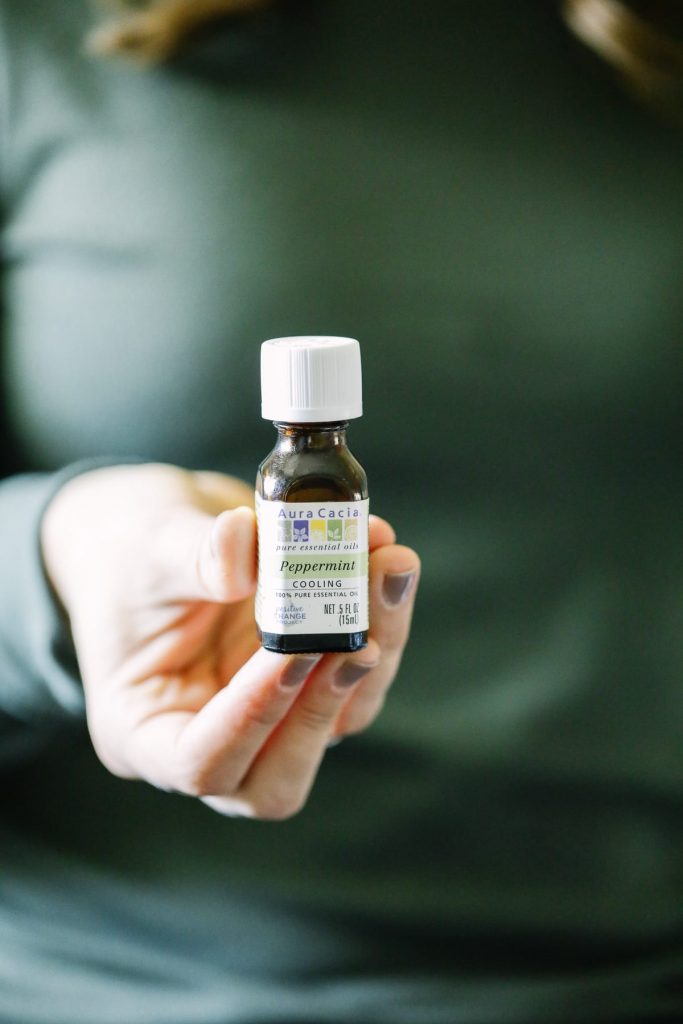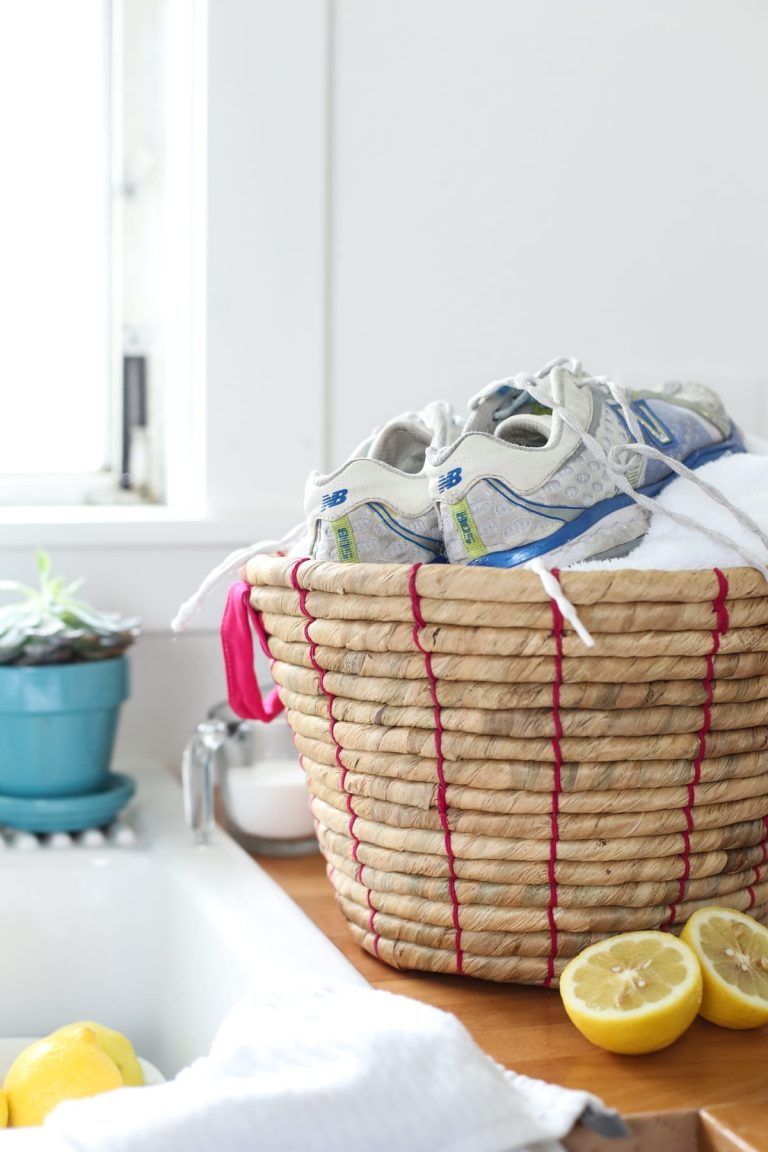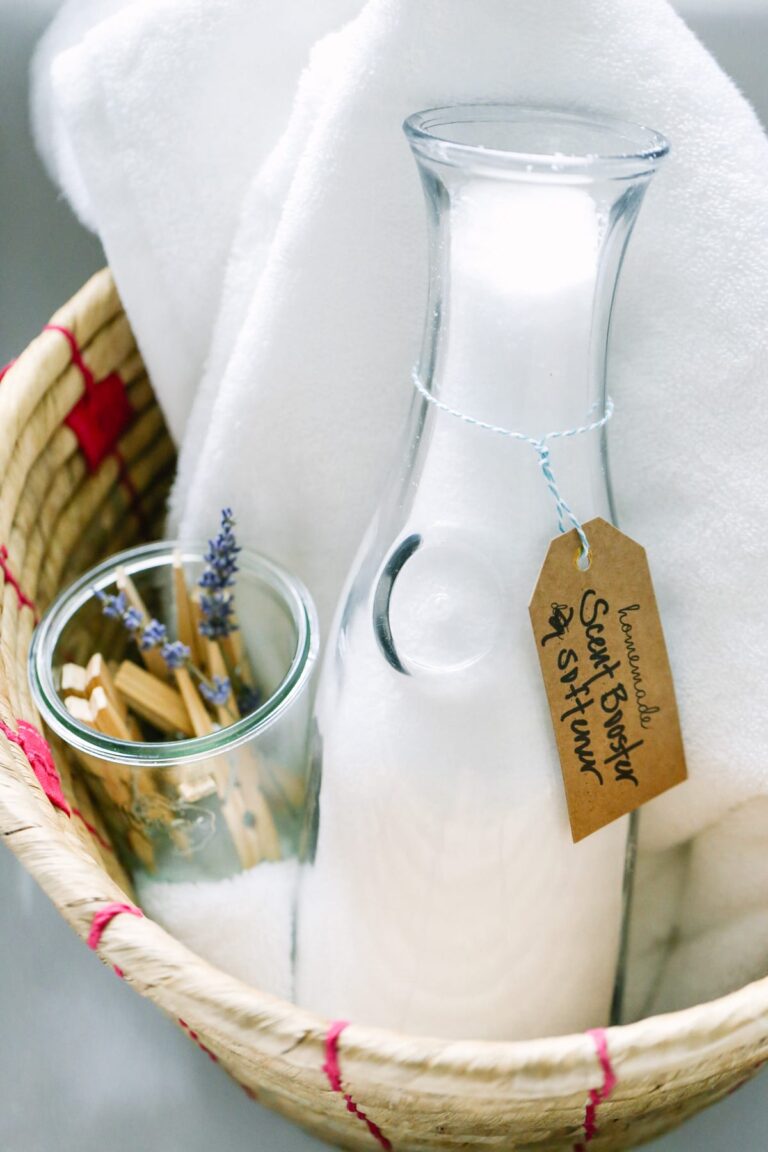There are lots of cleaning recipes here on the blog and in my cleaning book. My goal in providing so many different recipes is to help meet your specific needs when replacing toxic cleaners with more natural options.

Want to Save This Article?
Enter your email & I’ll send it straight to your inbox. And you’ll get new recipes & tips each week.
Over the past year, I’ve been looking for ways to simplify our home life even more. One of the ways I’ve simplified is in the cleaning department. I’ve limited the cleaning products used in our home to just a few basic ingredients. At this point, I’m able to clean my entire home with just three simple products: baking soda, vinegar, and Sal Suds. Oh, and a couple of essential oils.

If you’re looking to simplify your cleaning routine, today’s chat is for you. Let’s take a look at the three major cleaning products in my cleaning caddy. These products are versatile enough to clean multiple surfaces in multiple areas of the home.
Baking Soda
Baking soda is by far my favorite cleaning product. This simple, odorless ingredient is inexpensive and incredibly versatile. Baking soda cleans and deodorizes.

The Bathroom
Deodorize and Clean Toilets: Generously sprinkle baking soda around the interior of the toilet bowl, wait 10 minutes, and then use a toilet brush to scrub away stains and odors. If you’d like to add a fresh lemon scent, mix a few drops of lemon essential oil with the baking soda, and then follow the steps above.
Clean the Bathroom Tub and Sink: Sprinkle baking soda over the surface of a ceramic/porcelain bathtub and sink. Use a scrub brush or sponge to gently scrub the surface with the baking soda. As you scrub, the build-up that can occur on both surfaces will lift away, leaving behind a sparkly tub and sink. If you’d like to add a fresh lemon scent, mix a few drops of lemon essential oil with the baking soda, and then follow the steps above.
The Kitchen
Oven Scouring Powder: Sprinkle baking soda over the bottom surface of your oven, and then spray the surface (and baking soda) with water. Allow the wet baking soda to sit for a few hours, and then use a textured sponge to scrub away the build-up. Wipe the surface with a wet cloth, until the surface is clean. This isn’t a regular cleaning activity for me. Who has time to deep clean an oven on a regular basis? A spritz of all-purpose spray (made with vinegar and Sal Suds) is usually the only attention my oven receives.
Clean the Kitchen Sink: Sprinkle baking soda over the surface of a ceramic/porcelain sink. (I don’t have experience with other sink surfaces–always test a small area first.) Use a scrub brush or sponge to gently scrub the surface with the baking soda. I love watching the grease and dirt/food build-up magically disappear. Rinse the surface with clean water. If you’d like to add a fresh lemon scent, mix a few drops of lemon essential oil with the baking soda, and then follow the steps above.
Deodorize the Fridge: Regularly cleaning the fridge helps take care of most odors, but just to be safe I like to keep a jar of baking soda in the fridge. This baking soda helps to neutralize odors and keep them from overtaking the fridge (and other foods). Combine baking soda (1 cup) and a few drops of lemon essential oil in a storage container. Store the container/mason jar in the fridge. After a month, dump the baking soda (or use it to clean your sink or toilet bowl), and create a new deodorizer.
All Areas
Deodorize Carpets and Rugs: Between pets and kids, our carpets and rugs are subjected to all sorts of fun activities. In order to keep these surfaces smelling fresh, I sprinkle them with baking soda (whisked with a few drops of a favorite essential oil, like lavender essential oil), wait 30 minutes, and then vacuum the surface.
Magic Eraser: Baking soda is a natural magic eraser. I’ve removed crayon from walls and tables with just baking soda and water. It’s magical! A reader friend recently shared with me that she was able to remove red wine from her rug with baking soda and water. Sprinkle a wet cloth with baking soda and then gently wipe the wall (or another surface) with the cloth until the marks disappear. The results will depend on the kind of paint on your wall. Always test a small area first.
Distilled White Vinegar
If you can get over the initial vinegar smell, distilled white vinegar is a great household cleaner.

The Bathroom
Clean the Shower: We have poor ventilation in our upstairs bathroom, so I like to spray the shower tile with vinegar. Every so often, I use 100% vinegar with a few drops of tea tree essential oil in a spray bottle. The baking soda (mentioned above) is great for cleaning the tub, and the vinegar helps to kill any mold.
Clean the Toilet: Baking soda is my go-to product for cleaning the toilet (mixed with a few drops of essential oil). If you’d like to use a liquid product, vinegar is a simple solution. Spray the toilet bowl with vinegar, let it rest for a few minutes, and then scrub the toilet with a toilet brush.
The Kitchen
Clean Stainless Steel Surfaces: Spray a mixture of 50:50 vinegar and distilled water on a microfiber cloth, and then wipe the front of stainless steel appliances. Some appliances come with special care instructions, so always get to know your manual first. You’ll notice that this cleaner may also be used as an all-purpose cleaner (see “All Areas”).
Clean the Dishwasher: I’m going to throw this one out, although it’s not something I do as often as I should. Cleaning your dishwasher every so often is important. Vinegar is my go-to product for getting this done. Here’s a more detailed post if you’re interested in showing a little TLC to your hard-working dishwasher.
All Areas
All-Purpose Spray for Surfaces (not for granite or marble): Combine 50:50 water and vinegar in a spray bottle. The only caution is vinegar doesn’t agree with special stone surfaces, like granite and marble.
Hard Floor Cleaner: Add 2 gallons of warm/hot water to a large bucket. Add 1/2-1 cup of vinegar. Mop the floor. If you’d like a scent, add a few drops of your favorite essential oil. I usually go with the Sal Suds cleaner (next section); this is my backup floor cleaner. This floor cleaner isn’t suitable for special stone surfaces or some wood floors.
Sal Suds (Or Castile Soap)
When it comes to cleaning, I prefer Sal Suds (a Dr. Bronner’s product) over castile soap.
Castile soap is an amazing cleaning ingredient and can be used to make many different cleaning products.
But Sal Suds is even tougher and better for cleaning many times. It’s actually a detergent, making it extra tough on dirt and grease. And since it’s technically a detergent, it can even be combined with vinegar (a powerhouse combo). Sal Suds is also considered a natural disinfectant.

The Kitchen
Clean the Dishes (Dish Soap): Pour 1/2 cup of water and 1/2 cup of Sal Suds into a soap dispenser. Gently shake the bottle to combine the ingredients. Use this product as dish soap.
All Areas
Hard Floor Cleaner: Add 2 gallons of warm/hot water to a large bucket. Add 1/2 teaspoon of Sal Suds. Mop the floor. Sal Suds will not leave soap residue on the floor or other surfaces. If you’d like a scent, add a few drops of your favorite essential oil.
All-Purpose Spray for Surfaces: Pour 1 cup of distilled white vinegar, 1 cup of water, and 1/2 teaspoon Sal Suds into a 16-ounce spray bottle. Gently shake to combine the ingredients. I use this cleaner on just about every surface in my home–it’s my go-to all-purpose spray. This cleaner isn’t suitable for granite surfaces due to the vinegar which can be replaced with water.
If you prefer to use castile soap, check out 15 different ways to use castile soap for cleaning.
Essential Oil
Essential oils have beneficial cleaning properties and also add a nice scent to your home. I like lemon, peppermint, grapefruit, or lavender for cleaning. Start with just 1 or 2 oils that may be used in a diffuser (a great way to naturally scent your home) and mixed with cleaning ingredients.

cleaning solution
Natural Cleaning Made Easy
The fast-track way to reduce your chemical exposure, use natural cleaners, and create a healthier home environment.








Hi Kristin, I appreciate your blog and want to ask where you sourced your info for mixing sal suds with vinegar? According to Dr B’s site it has “normal ph of soap” which is slightly to extremely alkaline. Which in my understanding means its NOT a good option for mixing with vinegar (acid) … ??
Hey Savannah, Correct. You don’t want to mix soap with an acid. Here’s my post on that: https://livesimply.me/4-natural-cleaning-ingredients-to-avoid-combining/
Hi Kristin, I have a problem. My kitchen chairs are upholstered and I can’t get spots off them. Would Sal Suds work on them do you think? The fabric looks like linen but I’m not sure of the content. Thanks!
Sal suds has sodium lauryl sulfate which is extremely toxic.
Lisa Bronner of Dr. Bronner’s addresses the concern of sodium lauryl sulfate in this post. http://www.lisabronner.com/there-is-no-cancer-risk-from-sls-sodium-lauryl-sulfate/
What a great post! Rich with ideas and information!
hi Kristin, Thanks for this awesome post! ? It’s really great!
I have granite in my kitchen, what can I use there?
thanks a lot!!
Is there an alternative to Sal Suds? I have an allergy to coconut derivatives…
Hey Jennifer, Castile soap, but that would also be a no-no due to coconut. Vinegar is probably the best option, and using a natural dish soap without coconut derivatives for anything that requires soap.
When you say you use your all-purpose cleaner on “just about every surface” in your home … do you also use it for dusting?
I’ve been using a mixture of about 2 C distilled water + 1Tbsp Dr Bronner’s Castile soap and I love it for the kitchen counters, cabinet doors (wood), stovetop, as well as dusting throughout the house. It seems to work fine and with the lavender soap, it leaves the entire house smelling so clean and fresh. Is there any reason I shouldn’t use either my cleaner or yours with vinegar, on all of these surfaces?
Thanks so much for the info!!
Hey DB, I use it for dusting, too! Castile soap is a great all-purpose cleaner, and it’s safe to use on most surfaces. The only caution with vinegar is to avoid special stone surfaces or unsealed wood.
Hey Kristin! I just wanted to say that your blog is a godsend. I’ve been trying to transfer over to natural cleaning products for awhile now, but I always have a hard time finding great recipes or tips. I just ordered to Sal Sud’s and I can’t wait to try it. It will be replacing my Dr. Bronner’s Castile soap – which doesn’t cut the grease as well as I would like.
So thank you for sharing all of your knowledge.
I also look forward to trying some of your beauty products.
Oh, and one more question! What do you use to clean mirrors and windows? Thanks again!
Hi Kristin! Thanks for this awesome post! 🙂 It’s really great!
I noticed that you mentioned using “distilled” vinegar, but not distilled water. Is there a reason for that? And why do you use “distilled” vinegar?
Also, when you make your sprays do you use amber glass bottles. If so why is that preferable?
Thanks! 🙂
This is a great post! I have successfully tried several of your cleaning & beauty DIYs and your Sal Sud’s All Purpose Cleaner is the truth!! (meaning it really works). I usually add Tea Tree EO or Purification Blend EO to it. Oddly, I don’t smell vinegar at all unless I sniff the bottle directly and Tea Tree EO is the “clean” smell to me. I live in a high moisture area and all the homes have that green mold on the vinyl siding (unfortunately mine is white). After letting the cleaner sit for about 10 minutes, just wiping with a flour sack cloth removed all the dirt! Thank you for all you do!! It has truly made a difference in my life and for those I share my products & experiences.
Thank you so much, Pamela! I’m so glad to hear you’re enjoying it!